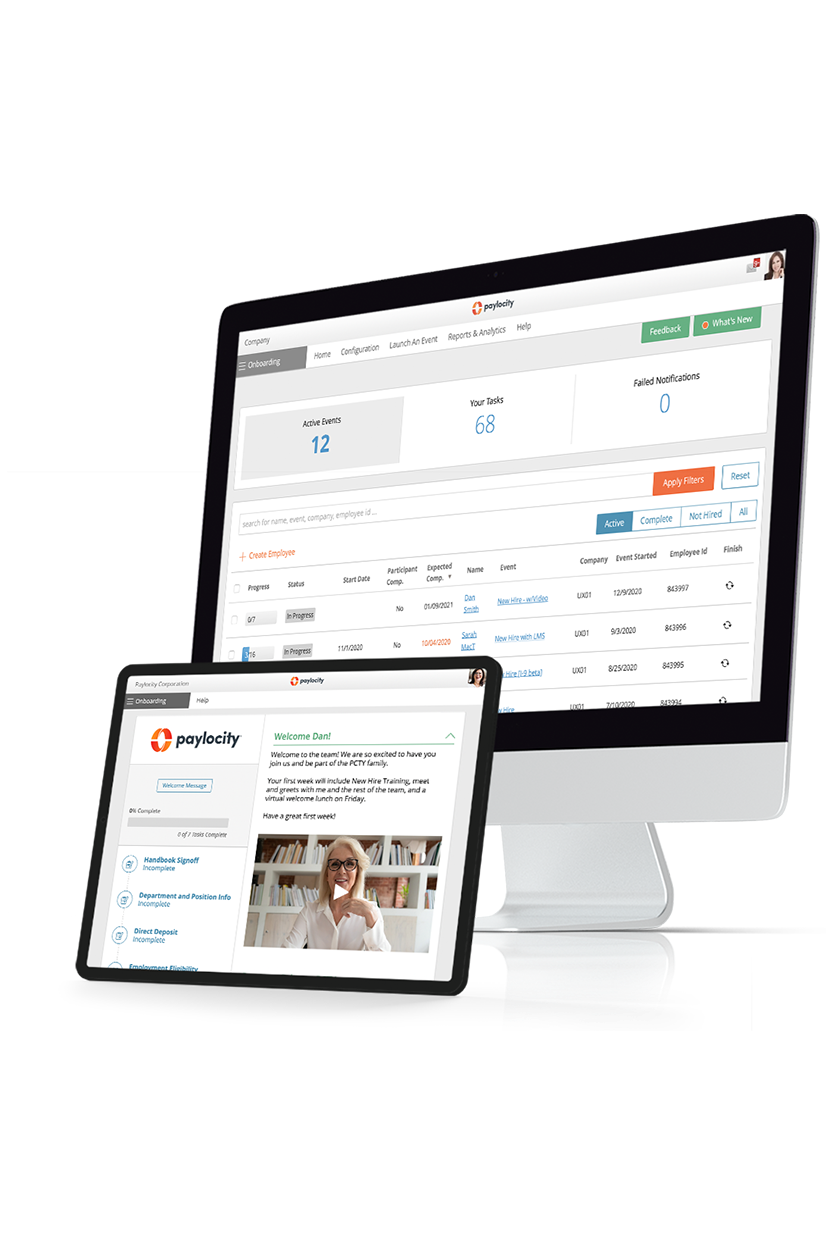resources
Employee Onboarding: Step-by-Step Guide to New Hire Success
April 12, 2024

Onboarding new hires isn’t a sprint, but it isn’t a marathon either. It’s really a triathlon, with HR professionals playing several key roles — coach, event organizer, and head cheerleader — to help employees transition through three distinct stages.
For employees trying to navigate a new role and a new company, onboarding maps out a path that will take them across the ultimate finish line: job satisfaction. But without careful planning and personalized support from HR and others, new employees can quickly feel overwhelmed, fall behind, and even drop out.
This guide will help you get your onboarding program in tip-top condition so that employees cross the finish line with ease, energized and ready to begin contributing to the business.
Key Takeaways
- Onboarding is more than paperwork — it's a strategic opportunity to embed new hires into the company culture.
- A comprehensive onboarding process spans from preboarding to the end of the first year, focusing on orientation, integration, and preparation for success.
- Effective onboarding is dynamic and continuous, emphasizing the importance of setting realistic goals, maintaining regular check-ins, and using feedback to foster a supportive environment.
What Is Employee Onboarding?
Employee onboarding is an opportunity to show new hires how your organization lives its values on a daily basis. It is a strategic initiative that demonstrates communication practices, internal processes, organization priorities, and the support employees can expect during their time at your company.
Beginning when a candidate accepts a job offer, the onboarding process lays the groundwork for employee engagement, productivity, and retention. Of course, there are certain steps that must be completed, like documenting employment eligibility and collecting tax withholding information. But while onboarding is often associated with paperwork, the heart of the onboarding process is setting up new hires for a long, successful tenure with your organization.
Keep in mind that onboarding is a two-way street. As you are ensuring the new employee is prepared to perform their job responsibilities, that employee is assessing everything about the onboarding experience. From enrolling for benefits to meeting teammates to completing job skills training, new employees are deciding if this is the right place and position for them.
When Does Employee Onboarding Start?
Onboarding technically kicks off when a new hire signs your offer letter. But many organizations don’t truly start onboarding until an employee’s first day.
Be proactive! Get a head start on onboarding by having your new employee complete some tasks ahead of time, such as employment paperwork or setting up their equipment. This process, known as preboarding and sets up new employees for success even before their first day.
Why Is Onboarding Important?
A new employee is only new once, which means you have only one opportunity to welcome them to your company. These first interactions are crucial to building a foundation of trust and goodwill.
Onboarding is a multi-faceted process that serves both practical and strategic purposes. New employees must complete required paperwork and prove they are eligible to work, while also learning your company’s systems, processes, and policies.
At the same time, they need to understand and buy into your company culture. As employees become more engaged, they become more productive.
In the long run, onboarding is key to retention, which impacts the bottom line. Employees who rate their onboarding experience as exceptional are 2.6 times more likely to be extremely satisfied with their workplace — and far more likely to stay.
Employee Onboarding Process
The onboarding process unfolds over five distinct stages, designed to seamlessly integrate new employees into your workplace.
1. Preboarding (The Initial Touchpoint)
Even before the first official day, our preboarding phase sets the stage for a smooth transition. This prelude to onboarding is where you begin to build a connection, sharing the workplace culture and what it truly means to be part of the team.
Essentials of the preboarding stage include:
- Early introductions via email or company communication platforms
- Preliminary paperwork to get the formalities out of the way
- Sneak-peeks into company culture through digital meet-and-greets
- Access to online resources for a head-start on company knowledge
- Setting up of workstations, accounts, and access for a day-one dive-in
2. Welcome Day (Orientation)
Welcome Day sets the tone for a new hire's journey, making it a day of warm introductions to the company's ethos and expectations. It's all about creating a sense of belonging and furnishing the crucial insights they need to thrive from day one.
Planned welcome-day activities include:
- Greetings and briefing with HR or leadership
- A guided tour of the workplace
- Introductions to the team (don’t forget ice-breakers!)
- Overview of company policies
- Benefits sign-up session
3. Week One (Acclimation)
In their initial week, new hires begin to navigate their roles and the lay of the land. It's a week dedicated to support and resource-sharing, helping them understand their place in the collaborative tapestry.
Focus areas for the first week:
- Training on job functions, company workflows, and systems
- Dialogue with mentors about role expectations and aspirations
4. The First Quarter (Integration)
The first 90 days are crucial for new employees to root themselves in the company culture and mesh with their team. The goal is to provide the tools and mentorship they need to excel and leave a mark.
The first quarter is filled with:
- Continuous learning and skill-building
- Regular feedback sessions for support and course correction
- Goal-setting to track and celebrate growth
5. Year One Milestone (Reflection and Projection)
As the first-year marker approaches, reflect on the progress made and the road ahead. It's a time to acknowledge achievements and strategize for future growth.
Key activities as the first year wraps up:
- In-depth performance evaluations
- Goal planning for the next chapter
- Conversations around career progression and opportunities for advancement
Every onboarding plan comes with defined milestones, but the details will differ depending on your industry and the composition of your workforce. See our employee onboarding checklist to help plan each phase step-by-step.
How Long Does Onboarding a New Employee Take?
The short answer is: as long as it needs to. Preboarding could be a few days or a few weeks. A new employee orientation must include enough time to complete any required paperwork, introduce new hires to your company, and cover core policies.
Following orientation, new employees often need additional job-specific training and intentional opportunities to connect with colleagues and the company.
Generally, an onboarding program continues at least through an employee’s first 90 days.
Employee Onboarding Best Practices
Once a new employee signs their offer letter, every interaction going forward influences their engagement in your organization and subsequent success. While there are t’s to cross and i’s to dot throughout the onboarding process, there are also strategic steps you can take to create a world-class new hire experience.
1. Get Buy-in from Leadership
There’s always some urgency to get new hires up and running. But rushing through the onboarding process may do more harm than good.
One in five companies report they have employees who do not show up on day one — a sure sign the preboarding process isn’t working. Half say they’ve had employees who didn’t return for day two.
Help leadership understand the importance of an engaging, smooth, and inspiring onboarding experience. Share estimated costs of turnover as well as efficiencies gained with a strategic onboarding plan that maximizes a new hire’s first few weeks. Other benefits to highlight include:
- Streamlined collection of required onboarding documents, letting new hires focus on learning about the company and their new role.
- Improved understanding and knowledge retention about company mission, values, policies, and culture.
- Increased employee engagement and faster time to productivity.
Case Study: Turning Chaos into Culture
See how Mountainside Fitness, a fast-growing chain of upscale health and fitness centers, saved 900 hours annually by implementing Paylocity’s Onboarding solution. With more time and less paperwork, Mountainside’s HR team can focus on engaging 100+ new hires a month in their people-first culture. Read the case study.
2. Focus Automation on the Employee Experience
Automating onboarding tasks increases HR efficiency, saving time, costs — and compliance headaches. But none of that really matters to a new employee.
Starting a new job can be a stressful time for anybody. Consider how automation actually makes the process of joining your company easier. For example, you can:
- Send welcome messages and instructional emails at intervals during preboarding to engage employees early without overwhelming them with information.
- Guide new hires through eligibility and payroll documentation using an online self-service portal to minimize first-day paperwork.
- Notify other teams when they need to take action, like setting up direct deposit or creating login credentials when new hires submit necessary forms.
- Schedule surveys following orientation and at 30, 60, and 90 days to gauge onboarding effectiveness and to let new employees know their feedback is valued.
3. Leverage the Communication Tools Employees Use
Providing access to HR and payroll tools through a mobile app is both convenient for employees and a time-saver for HR. A mobile app is an instant way to connect with new hires and engage them in the onboarding experience. Sending a friendly reminder to submit documents, starting a welcome post on your internal social hub, and responding quickly to questions lets new hires know their success is important to you.
Similarly, workers today are used to highly personalized multimedia experiences in their everyday life. People pay closer attention to video than any other medium, making it an ideal vehicle to share your company’s values, policies, culture, and more.
Some ways to make a big impression on new hires using video touchpoints during the onboarding experience include:
- Incorporate a video greeting from your CEO into your preboarding communications.
- Give a quick video tour of your facility for onsite employees so they know what to expect on day one. (Remote employees enjoy seeing your headquarters too, but make sure you’re not highlighting benefits they can’t access, like an onsite gym or free snacks in the kitchen.)
- Introduce colleagues in different locations or departments.
- Pair up each new hire with an onboarding buddy and get the conversation rolling with a “Top 5 Fun Things About the Company” video.
Podcast: Beyond Onboarding — The Next Revolution
Check out other tips to reinvent the onboarding experience with modern communication tools in this podcast with Paylocity HR experts.
4. Make Connections Intentionally
Whether employees are in the office, on the plant floor, or WFH, helping them establish connections early on is vital to their success — and their retention.
Even before the pandemic, workers craved connection, with 77% stating that relationships with their colleagues are a key indicator of job satisfaction. To be sure, integrating remote workers adds another layer of complexity to building a social support system.
With a little help from HR in the onboarding process, new employees can quickly feel engaged on a personal level. Here are a few ways you can facilitate connections:
- Invite leaders to do an informal Q&A with new hires during orientation either in person or through video conferencing.
- Have guest speakers from your employee resource groups explain their purpose and highlight opportunities to get involved.
- Provide a template for employees to announce their new job on social media so that coworkers can find and connect with them.
- Schedule meet and greets in those first few days between new employees, their supervisors, and their teams.
- Show employees where to find answers to frequently asked questions and how to reach out for additional help, such as submitting an IT support ticket.
5. Kick Off the Career Path Discussion
One of the most important parts of onboarding is helping employees envision a future with your company. Employees who strongly agree they have a clear plan for their professional development are 3.5 times more likely to strongly agree that their onboarding process was exceptional.
By starting the career development conversation during orientation and continuing it afterwards, you communicate that your organization is committed to employees’ long-term success. Encourage new employees to start planning their career path by:
- Soliciting their feedback at regular intervals during the onboarding process and providing space for them to share their goals and aspirations.
- Highlighting career development benefits your company offers, such as skills and leadership training, tuition reimbursement, career fairs, and professional conferences or memberships.
- Recognizing achievements and milestones through company-wide peer recognition.
6. Evaluate for Continuous Improvement
Throughout the onboarding process and beyond, there are many opportunities to measure the effectiveness of your program by collecting and analyzing qualitative and quantitative data. Not only will data help you identify areas for improvement, it also provides several key metrics that matter to your executives.
Indicators of onboarding success include:
- Employee feedback surveys: Periodic employee satisfaction surveys can reveal the ongoing health of your employee experience.
- Retention rates and threshold: Examine the length of time employees stay at your organization.
- Time to productivity: How long does it take for a new hire to start contributing to their team or the company overall?
- Exit interviews: Ask employees who stay less than a year how their onboarding could have better prepared them.
- Performance metrics: Track new employee progress to assess whether they are achieving onboarding milestones, such as completing compliance training.
Of course, the best way to understand what works and what doesn’t is to ask. Be sure to survey new hires specifically regarding their onboarding experience immediately following orientation and periodically thereafter. And don’t be afraid to host focus groups so employees can voice their perspectives more thoroughly.
The Advantages of Using Technology for Onboarding New Employees
When onboarding practices fall short, you can lose new hires before they have an opportunity to make meaningful contributions to your business — and your organization can rack up serious turnover costs.
Thankfully, HR tech can be an invaluable ally in building a smooth and simple onboarding program.
Paylocity's onboarding software streamlines the process, enabling a completely electronic journey from any device, in any location. Minimize the time it takes for new team members to get up to speed and immerse them in your culture right away with features like:
-
Easily collect documentation. A wizard-driven onboarding tool takes new hires step by step through handbook acknowledgment, collecting emergency contact details, setting up direct deposit, and more.
-
Onboarding check-ins. Send 30-, 60-, and 90-day surveys to stay apprised of how new employees are acclimating.
-
Streamline training. Automatically assign and track new-hire training in Learning Management System to ensure new hires have the resources they need from the start.
Want to learn more? Request a demo today!

Make Your First Impression Count
An impactful employee experience begins before day one. Make data collection, tax paperwork, and direct deposit setup seamless so you can begin engaging your new employees immediately with our onboarding tool. Help make your new hire’s first day memorable in the best way possible with less process and more human connection.

